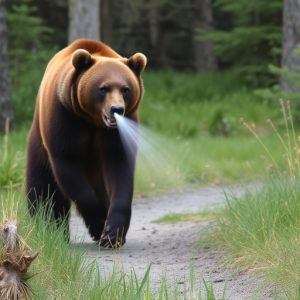Wilderness Survival: Defending Against Grizzly Bears with Bear Spray & Water Safety
Grizzly bear interactions can be safely navigated through understanding their behavior, avoiding sud…….
Grizzly bear interactions can be safely navigated through understanding their behavior, avoiding sudden movements near water sources, and properly using bear spray. Key points include recognizing behavioral patterns, applying bear spray cautiously (aiming for face and eyes), managing runoff to prevent backspray, and practicing water safety in grizzly bear country. Keeping calm, securing water sources, and adhering to local guidelines are vital for minimizing risks during encounters and promoting safe wilderness experiences.
In the vast wilderness, encountering a grizzly bear can be a thrilling yet potentially dangerous experience. Understanding their behavior and charging patterns is key to staying safe. This article equips readers with essential knowledge to defend themselves against these powerful creatures. We explore effective strategies, including the use of bear spray and water safety techniques, to navigate encounters successfully. Learn vital tips for prevention, escape routes, and post-encounter procedures, ensuring a safer journey through nature’s wild realms.
- Understanding Grizzly Bear Behavior and Their Charging Patterns
- The Role of Bear Spray in Wilderness Safety: How It Works and When to Use It
- Navigating Water Safety Concerns During Encounters: Preventing and Managing Runoff
- Essential Tips for Avoiding and Escaping a Charge from a Grizzly Bear
- Post-Encounter Procedures: What to Do After a Close Call with a Bear
Understanding Grizzly Bear Behavior and Their Charging Patterns
Grizzly bears are powerful and unpredictable animals, and understanding their behavior is crucial for safety in wild environments. These bears have a reputation for charging when they feel threatened or surprised, but their charges aren’t always aggressive. They may charge to protect their young or food sources, but sometimes it’s a playful display of curiosity. Recognizing these patterns can help hikers and campers avoid unnecessary confrontations.
Bear spray is often recommended as a defense mechanism against grizzlies, but it should be used cautiously. Proper application techniques are essential, focusing on the bear’s face and eyes to temporarily disable it. However, runoff from water sources after spraying can reduce the effectiveness of the spray. It’s important to stay calm, back away slowly, and only use bear spray as a last resort when direct confrontation is unavoidable.
The Role of Bear Spray in Wilderness Safety: How It Works and When to Use It
Bear spray is a crucial tool for self-defense against charging grizzly bears in the wilderness. It’s designed to deter and temporarily incapacitate bears, providing precious time for escape or retreat. The active ingredient in bear spray is usually capsaicin, the same compound that gives chili peppers their heat. When sprayed, it irritates the bear’s eyes, nose, and respiratory system, causing them to pause and retreat.
Understanding when to use bear spray is vital for wilderness safety. It’s most effective at close range, within 20-30 feet (6-10 meters), but can be used as a last resort from farther away. When facing an aggressive bear, it’s important to remain calm, raise the spray canister above your head, and spray directly into the wind. Aim for the bear’s face and eyes for maximum impact. After spraying, create distance quickly and quietly, ensuring the spray hasn’t mixed with runoff water, as this could reduce its effectiveness.
Navigating Water Safety Concerns During Encounters: Preventing and Managing Runoff
When encountering a grizzly bear in wild terrain, water safety is an often-overlooked aspect of defense. During encounters, it’s crucial to understand that bears are attracted to water sources for drinking and cooling off, so staying near rivers or lakes can increase the risk of an aggressive interaction. Preventing sudden movements that might startle a bear is key, especially when crossing streams or navigating through wet areas. Using bear spray effectively can deter bears, but it’s important to manage runoff; direct the spray towards the bear’s face and avoid wind assistance to minimize backspray that could reach you.
Properly disposing of waste and avoiding food storage near water bodies are additional measures. Keeping a safe distance from water sources during your hike or camp setup reduces the chances of an unexpected encounter. Always follow local guidelines and be aware of the terrain, as some areas may have known bear habitats or water gathering spots. Staying informed and prepared can significantly enhance your wilderness experience while minimizing potential risks associated with water safety in grizzly bear country.
Essential Tips for Avoiding and Escaping a Charge from a Grizzly Bear
When facing a potential encounter with a grizzly bear, knowing how to respond is crucial for your safety. Here are some essential tips to help you avoid and escape a charge from one of these powerful animals.
First, maintain your calmness and do not run. Grizzly bears have an incredible sense of smell and can detect fear. Running may trigger their chase instinct. Instead, slowly back away while facing the bear, allowing it ample space to retreat. If you have bear spray, ensure it’s within reach and properly prepared for use. Aim for the bear’s face and eyes when spraying, as this is the most effective way to deter an attack. Always remember that proper storage and application techniques for bear spray are vital, especially in emergency situations. Keep your water sources secure and covered to prevent any unwanted interactions with curious bears attracted by runoff water.
Post-Encounter Procedures: What to Do After a Close Call with a Bear
After a close encounter with a grizzly bear, it’s crucial to understand the appropriate post-encounter procedures to ensure your safety and the well-being of the animal. The first step is to remain calm and assess your situation; quick reactions can help prevent further aggression from the bear. If you have used bear spray successfully, ensure that all runoff water is contained and disposed of properly to avoid contaminating the environment.
Water sources are essential for bears, so always practice water safety when in bear country. Avoid drinking or cooking with affected water nearby; clean your equipment thoroughly to prevent any scent that might attract bears. It’s a good practice to carry extra supplies, including a reliable source of water and food stored securely, to minimize the risk of future encounters.
When navigating wilderness areas known for grizzly bear populations, understanding their behavior and employing strategic safety measures like using bear spray effectively can significantly enhance your water safety. By being aware of charging patterns and following essential tips for avoiding and escaping encounters, you can minimize risks. Remember, proper post-encounter procedures are crucial after a close call with a bear. Stay informed, respect wildlife, and prioritize safety through proactive measures like keeping food secure and making noise to deter bears. Combining these strategies equips you to confidently enjoy the outdoors while mitigating potential dangers from grizzly bears and other wildlife encounters.


